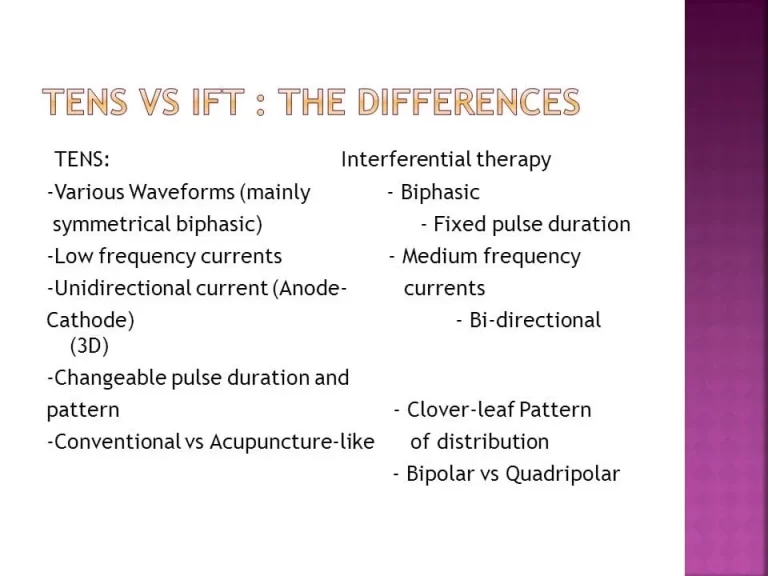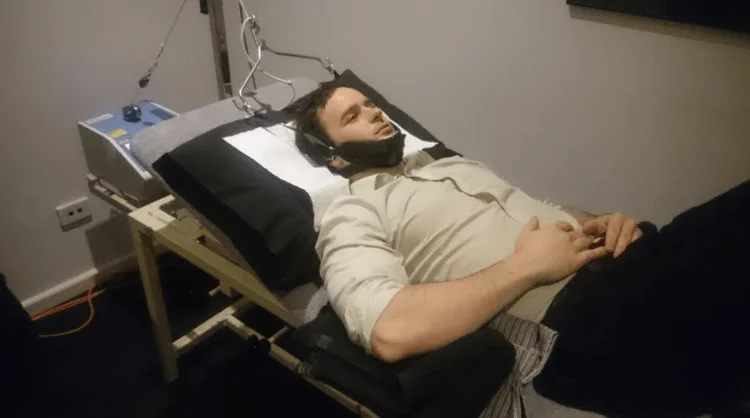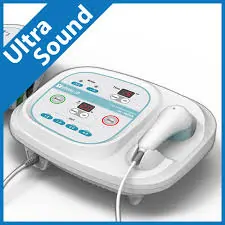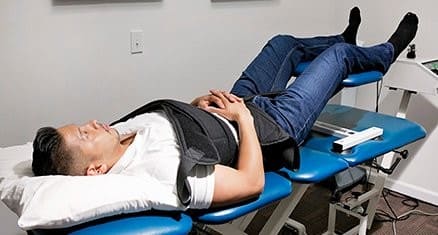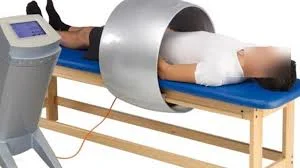Combination Therapy (Ultrasound and Interferential Therapy)
A Combination of Therapy: What is It?
Combination therapy often entails using electrical stimulation therapy and ultrasound (US) at the same time. While diadynamic currents are widely used in Europe, bipolar interferential current therapy (IFC) is most commonly used in conjunction with the US in the UK.
The high-frequency modality known as therapeutic ultrasound has both nonthermal and thermal effects. Non-thermal effects encompass increased protein synthesis, membrane changes, tissue healing, and sonic streamers and compression that enhance the process of inflammatory response. Thermal effects include increasing tissue metabolism, collagen elasticity, and capillary blood flow as well as reducing skeletal muscle spasm. Tissues high in collagen content utilize it well. Osteoarthritis and other musculoskeletal disorders are treated with interferential current treatment (IFT) to relieve pain.
Combination therapy involves using two distinct modalities simultaneously at the same location in order to simultaneously produce, apply, and achieve the therapeutic benefits of both modalities. One modality’s boosting influence over the other is observed during such an application. Few studies have found that applying a combination therapy is a more effective way to relieve pain than using an individual technique.
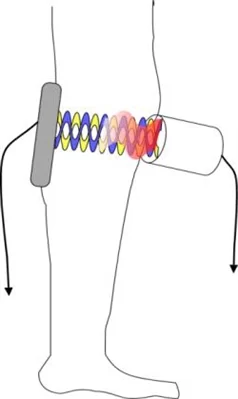
US with the IFT
Bipolar IFT involves applying the US head to the painful location and placing the IFT electrode over an adjacent area. This application lessens the adaptation that is often brought about when IFT is employed as the only modality.
Combination therapy’s mechanism:
A peripheral nerve’s resting potential is decreased when it is exposed to the US because it becomes more permeable to different ions, particularly calcium (Ca++) and sodium (Na+). This modified permeability brings the nerve membrane closer to its depolarization threshold but typically prevents the nerve from exploding. The depolarization potential is induced by the simultaneous application of an interferential current to the nerve; however, because of the potentiation effect of ultrasound therapy, a smaller current than usual will be required to achieve this.
It’s easy to show this. The feeling created by the IFT will lessen even if the IFT intensity remains constant if both the US and IFT are applied and the US is dialled down to zero during the application. When the US is cranked up again, the IFT experience returns in full force.
When combined with IFT, the US seems to have fewer negative treatment effects than when combined with other electrical stimulations, such as diadynamic currents. It has also been suggested that the US-IFT combination can offer a deeper effective treatment depth, albeit there is no hard evidence to back this claim.
Combining the two therapy modalities seems to preserve each of the specific effects of the therapies; nevertheless, the advantage is that outcomes can be obtained with lower treatment intensities, and there may be further advantages in terms of diagnosis and treatment duration.
Benefits of Combination Therapy:
It is proposed that:
The benefits of each therapy modality can be obtained by combining US and IF, however the result requires lower intensities to be felt.
the IFT treatment’s accompanying accommodation effects are diminished, if not completely eradicated.
The following have been listed as the primary benefits of such a combination:
- in accurately localising lesions (particularly chronic ones), i.e., using diagnostics to ensure precise localization of US treatment
- to improve precision and efficacy in treating deeper lesions and trigger points.
Using Combined Therapy for Diagnostic Purposes:
For this technique, it is recommended to utilise a constant US output of 0.5W/cm2, while many practitioners report significant effects at lesser intensities. If available, a frequency of 1 MHz is preferred since it penetrates tissues more effectively. The most popular setting for the IFT output using a bipolar output is 100Hz (no sweep).
Method:
Align the indifferent electrode (the standard IFT pad electrode) so that the current can flow through the affected tissue. Generally speaking, it might be positioned on the opposite side of the limb (for deeper lesions) or on the same aspect of the limb (more common for superficial lesions).
First, turn on the US, then the IFT (with the same specifications as before).
When the patient experiences “normal” tingling, progressively raise the IFT output intensity, starting with the US head far from the lesion.
Approach the location of the lesion and record any areas of increased sensitivity or pain, either local or referred.
The focal point of the lesion is thought to represent the place of highest sensitivity; nevertheless, it simply indicates a “geographical” location and cannot reveal information about the specific tissue involved or its depth. This is typically a repeatable and consistent position.
Utilising Combined Therapy for Treatment:
Combination therapy can be used for both therapeutic and diagnostic purposes. When both the IFT and US therapeutic benefits have been demonstrated, it is appropriate to use it as a treatment. This seems to be the only rationale for the modality at this moment, without any specific proof of further benefit when used in combination.
The specific dosages for each of the US and IFT should be determined by taking into account the lesion’s needs and desired outcomes. There’s no proof that special’ therapy dosages are necessary. It should be mentioned, nevertheless, that a lower-than-normal IFT intensity will probably be needed to provide the desired result.
A swing in the IFT dosage, according to some manufacturers, is unnecessary because the effect of accommodation is minimal. IFT- the needed effect can be achieved with an acceptable frequency swing, there doesn’t seem to be any reason why it shouldn’t be employed.
The US component would typically end first, leaving the IFT part to continue in isolation, therefore if the treatment times are different, there could be an issue. The combination of the modalities can save time and effort when the required treatment times are similar, even if no additional benefit is observed. Applying two different therapies may be just as beneficial when they are not the same.
During combination treatment, it’s critical to follow the safe and efficient US treatment approach, which calls for constantly employing a moving treatment head, maintaining effective contact, and, whenever achievable, keeping the treatment head and patient’s skin perpendicular.
Examples of Treatments:
The patient has an acute ankle lateral ligament tear or lesion. The justification for ultrasound is that it will accelerate the healing and inflammatory process, whereas the use of interferential is due to its ability to lessen acute pain.
US dosage (calculated using the standard dose)
10 minutes, 3MHz, 0.2 W/cm2, Pulse 1:4.
Interferential dosage (for bipolar, acute pain): 90–130 Hz, 10 min
With the US treatment head placed over the damaged component or components of the lateral ligament, an overlapping pad electrode is positioned medially at the ankle.
Although there is no proof that utilising both modalities simultaneously has any advantages to using them sequentially, the treatment may be more effective than using each one alone.
Side effects of Combination Therapy:
- Skin irritation: At the application site, both ultrasound and interferential therapy may cause moderate skin irritation, such as burning or redness. Usually only transitory, this resolves on its own following therapy.
- Burning: An excessively high ultrasonic intensity or insufficient applicator movement may result in a burning sensation on the skin.
- Bleeding: Ultrasound therapy may in rare instances result in mild bleeding, particularly when applied to regions with thin skin or ruptured blood vessels.
- Side effects of electrical stimulation: Tingling, prickling, or twitching of the muscles may occur during treatment with interfereential therapy. These feelings ought to be moderate and bearable.
Contraindications:
Apart from the limitations associated with the separate modalities, there don’t seem to be any particular contraindications for combination therapy.
FAQs
Which limitations does ultrasound therapy have?
If used for extended lengths of time, the skin may get superficially burned.
Is the body safe from ultrasound?
While ultrasound is generally regarded as safe when performed carefully by medical professionals with the necessary training,
Does sciatica benefit from ultrasound?
It’s a focused, non-invasive therapy that can aid in lowering inflammation, enhancing circulation, and encouraging healing. Although it might not be a panacea, it can undoubtedly make a big difference in how well your sciatica pain is managed and how much better your life is.
In physiotherapy, what is ift?
A non-invasive physical therapy for tissue repair and pain reduction is called interferential therapy (IFT). It works by creating a frequency with low-frequency electrical currents that are designed to stop pain signals from reaching the brain. An interferential current, or IFC, is the term for this frequency.
Which circumstance makes it inappropriate to use it?
Although there aren’t many contraindications, individuals who present with very severe inflammation, fever, tumours, thrombosis, pregnancy, a strong allergy to this kind of therapy, or who have a cardiac pacemaker should probably not be treated.
In IFT, where should electrodes be placed?
IFT electrode implantation approach for “painful area” At the edges of the painful region associated with LBP, two electrodes were positioned bilaterally or unilaterally.
References
- Dhameliya, N. (2023a, May 11). Combination Therapy (Ultrasound and Interferential Therapy). Samarpan Physiotherapy Clinic. https://samarpanphysioclinic.com/combination-therapy/


